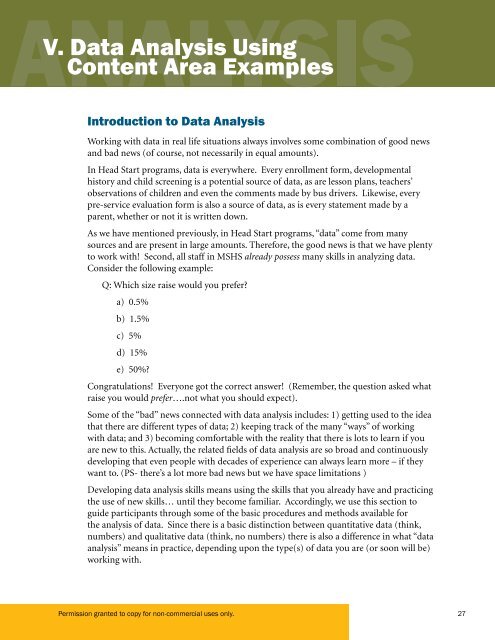Introduction to Data Analysis Handbook - AED Center for Early Care ...
Introduction to Data Analysis Handbook - AED Center for Early Care ...
Introduction to Data Analysis Handbook - AED Center for Early Care ...
You also want an ePaper? Increase the reach of your titles
YUMPU automatically turns print PDFs into web optimized ePapers that Google loves.
V. <strong>Data</strong> <strong>Analysis</strong> Using<br />
Content Area Examples<br />
<strong>Introduction</strong> <strong>to</strong> <strong>Data</strong> <strong>Analysis</strong><br />
Working with data in real life situations always involves some combination of good news<br />
and bad news (of course, not necessarily in equal amounts).<br />
in Head Start programs, data is everywhere. Every enrollment <strong>for</strong>m, developmental<br />
his<strong>to</strong>ry and child screening is a potential source of data, as are lesson plans, teachers’<br />
observations of children and even the comments made by bus drivers. Likewise, every<br />
pre-service evaluation <strong>for</strong>m is also a source of data, as is every statement made by a<br />
parent, whether or not it is written down.<br />
As we have mentioned previously, in Head Start programs, “data” come from many<br />
sources and are present in large amounts. There<strong>for</strong>e, the good news is that we have plenty<br />
<strong>to</strong> work with! Second, all staff in MSHS already possess many skills in analyzing data.<br />
Consider the following example:<br />
Q: Which size raise would you prefer?<br />
a) 0.5%<br />
b) 1.5%<br />
c) 5%<br />
d) 15%<br />
e) 50%?<br />
Congratulations! Everyone got the correct answer! (Remember, the question asked what<br />
raise you would prefer….not what you should expect).<br />
Some of the “bad” news connected with data analysis includes: 1) getting used <strong>to</strong> the idea<br />
that there are different types of data; 2) keeping track of the many “ways” of working<br />
with data; and 3) becoming com<strong>for</strong>table with the reality that there is lots <strong>to</strong> learn if you<br />
are new <strong>to</strong> this. Actually, the related fields of data analysis are so broad and continuously<br />
developing that even people with decades of experience can always learn more – if they<br />
want <strong>to</strong>. (PS- there’s a lot more bad news but we have space limitations)<br />
Developing data analysis skills means using the skills that you already have and practicing<br />
the use of new skills… until they become familiar. Accordingly, we use this section <strong>to</strong><br />
guide participants through some of the basic procedures and methods available <strong>for</strong><br />
the analysis of data. Since there is a basic distinction between quantitative data (think,<br />
numbers) and qualitative data (think, no numbers) there is also a difference in what “data<br />
analysis” means in practice, depending upon the type(s) of data you are (or soon will be)<br />
working with.<br />
Permission granted <strong>to</strong> copy <strong>for</strong> non-commercial uses only.<br />
2



